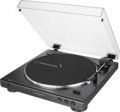Non-removable
The presence of a non-removable pickup in the design of the player.
The pickup (cartridge) is a key part for any turntable; failure of this part renders the entire device unusable. Therefore, non-removable (that is, unsuitable for replacement without disassembly in a workshop) pickups are made mainly in low-cost players, where the manufacturer tries to simplify and, accordingly, reduce the cost of construction. However, even in such models, usually, it is possible to replace the most delicate part of the pickup — the needle.
Model
Model of the pickup (cartridge) supplied with the player. The pickup is one of the most important parts of any vinyl player, the quality of the received sound largely depends on its quality. Knowing the name of the model, you can find detailed data on it and determine how satisfied you are with this particular cartridge.
Needle shape
The shape of the needle in the pickup (cartridge) that the player is equipped with.
—
Conical. It may also be called spherical. The simplest type of needles for vinyl players. Such needles are inexpensive, but the sound quality when using them is relatively low — due to the fact that the shape of the needle rather weakly matches the shape of the groove on the record.
—
Elliptical. Elliptical needles have a narrower shape than conical (spherical) needles, which improves contact and allows, in particular, more accurate reproduction of high frequencies, and also reduces record wear. Due to the good value for money, this option is very popular.
—
Linear. The most advanced variety: sharply sharpened needles of complex shape, following the contours of the grooves on the plate as accurately as possible and having the largest contact area among all types. The downside of this is the complexity in production and, accordingly, the high cost.
Output level
The signal level at the output of the pickup supplied with the player is, in fact, the power of the signal coming from the pickup to the phono stage. This parameter is necessary, first of all, in cases where the player is planned to be connected to an external phono stage: such equipment must be designed for the corresponding power of the signal coming from the pickup.
Downforce
The force of pressing the needle on the plate, which the complete pickup (cartridge) is designed for.
This force depends on the rigidity (compliance) of the needle: the greater the clamping force, the harder the cartridge, respectively, the less pliable it is. It is also believed that less pressing force wears out the record less, but it cannot be said that "light" cartridges are definitely better — there are many other nuances. So in fact, information about the pressing force of a complete pickup is needed mainly in case of its replacement. Usually, the pressing force provided by the arm of the turntable is regulated within these limits, so the new cartridge must also be rated for the same values of downforce — otherwise there is a chance that the turntable will not be able to correctly align.
Pickup weight
The weight of the pickup (cartridge) supplied with the turntable.
The weight of the cartridge determines the characteristics of balancing the tonearm to set the optimal tracking force. However, pickups in set are usually optimally compatible with the corresponding tonearms, so there are no problems with adjusting the turntable. But when buying a replacement cartridge, you should pay attention to this parameter: it is advisable that the new cartridge does not differ too much in weight from the old one, otherwise the tonearm adjustment range may not be enough for the correct balance.
Material
The main material used in the construction of a complete tonearm.
-
Aluminum. This is a fairly lightweight and durable material that has average characteristics in terms of sound quality: it does not dampen extraneous vibrations as well as carbon, but for entry-level and mid-level turntables this is quite enough; in expensive models, you can use other methods of eliminating interference, and aluminum is noticeably cheaper.
—
Carbon. A high-quality material that is lighter in weight and has more advanced anti-resonance properties than the metal described above. The main disadvantage of carbon fiber is its rather high cost.
- Plastic. Plastic is inexpensive, but this is perhaps its only key advantage: the performance characteristics of this material are quite modest. That is why it is used extremely rarely - mainly in retro-style players, where a plastic tonearm is a necessary part from a design point of view.
Tonearm effective length
The effective length of a tonearm in set is the distance from the attachment point (axis of rotation) to the stylus.
This indicator is important primarily for rotary tonearms: the longer the length, the lower the angular error, the smaller the discrepancy between the direction of movement of the track and the longitudinal axis of the pickup (for more details, see “Type”) and the lower the level of corresponding distortion. In addition, a longer length reduces the resonant frequency and reduces the likelihood of distortion. On the other hand, a longer tonearm turns out to be heavier, which requires certain technical tricks and can also negatively affect the purity of the sound. Therefore, a large length is not always a guarantee of high quality – you should also pay attention to weight (see below).
Tonearm weight
Operating weight of the complete tonearm. It is believed that this indicator should be as low as possible — in order not to create excessive pressure and to minimize the wear of the needle and records. On the other hand, a rigid pickup on a light arm can bounce on uneven records, and in general, such a discrepancy does not improve the sound quality. However, complete tonearms are usually optimally compatible with complete pickups; therefore, you should only be interested in compatibility when buying a cartridge of a different model.
